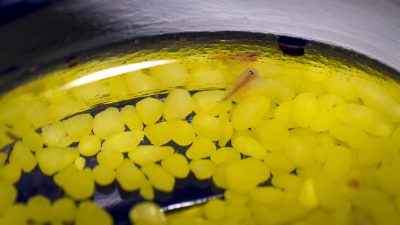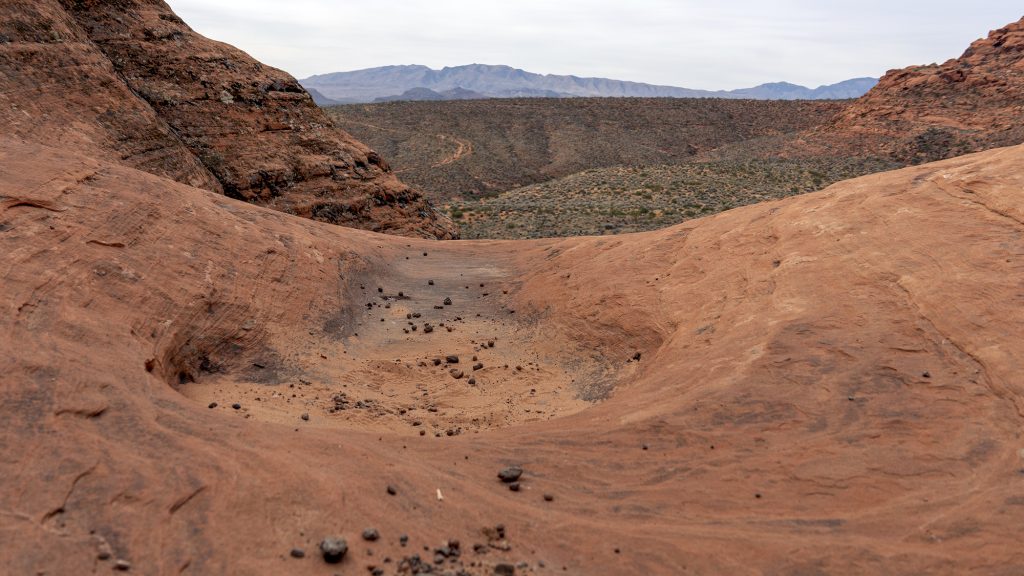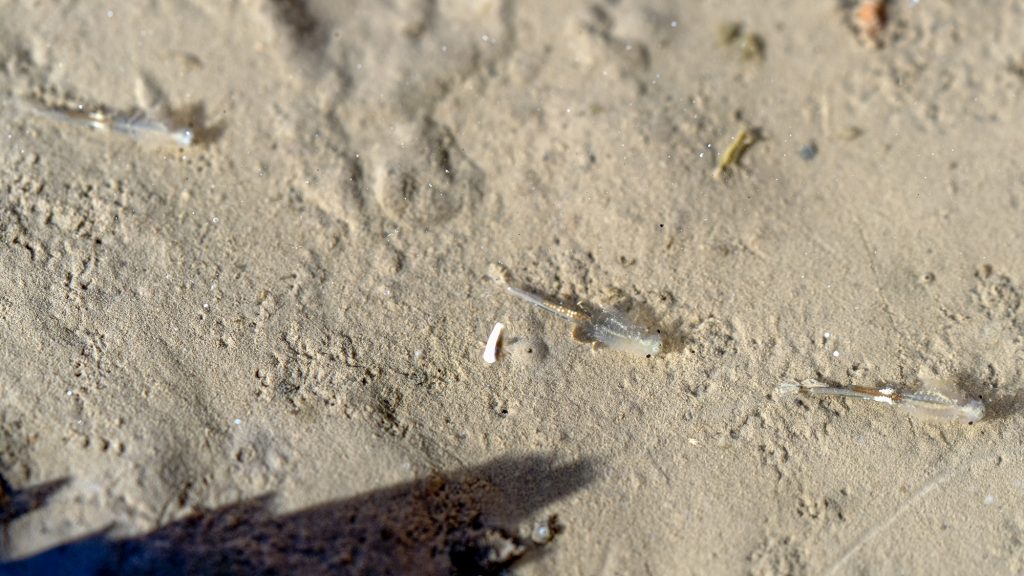ST. GEORGE — “Life finds a way,” Dr. Ian Malcolm argued in “Jurassic Park,” and so it holds true for the aquatic creatures living in Southern Utah’s seasonal pools.

Throughout the region, hikers may see depressions or water pockets in sandstone called potholes, such as those in Zion National Park or Snow Canyon’s petrified sand dunes. Snow Canyon State Park Lead Ranger Josey Gardner said visitors should not walk in them even when dry to avoid crushing eggs as they seasonally fill with water and spring to life.
Fairy shrimp and triops, a type of tadpole shrimp, are just two animals that might be spotted in ephemeral ponds, Gardner told St. George News.
“They’re just waiting for water in order to come back to life,” she said.
These small, ancient-looking creatures are branchiopods, a class of crustaceans that also includes brine shrimp, water fleas and clam shrimp.

A swarm of fairy shrimp was found in deep tire tracks near Duck Creek, where they laid eggs. In Arizona, Dorreen Dickinson said she found triops swimming in a small pothole while hiking at The Wave.
“Everyone was walking around the pool of water, avoiding it. I was amazed at what was in it,” she wrote in an email. “That’s the only place so far (I’ve seen them). It was pretty amazing. It’s incredible with such a tiny spot of water that they can keep coming back.”
When their temporary water sources dry up, the crustaceans’ eggs enter a state of suspended animation called cryptobiosis, allowing them to tolerate losing over 90% of their total body water, according to the National Park Service.
By maintaining a hydrated “command center” and replacing water with sugar molecules throughout the rest of their bodies, these creatures can withstand long periods of drought and other harsh conditions, service staff writes. For instance, brine shrimp eggs, called cysts, were hatched after taking a ride on the outside of a spacecraft.

“I jokingly called them time travelers,” Thomas Hegna told St. George News. “Not with a time machine. It’s more like waking-up-from-cryogenic-stasis sort of time travelers. The parents lay the eggs, and they will never meet their babies. Their babies will hatch out at some future point when the rains come back.”
Hegna is an associate professor at the State University of New York in Fredonia, New York, primarily studying fossils but also identifying living fairy shrimp species. He has studied trilobites near Delta and led a field trip to Utah national parks, taking a detour to see potential clam shrimp fossils at the St. George Dinosaur Discovery Site at Johnson Farm.
The crustaceans’ eggs can live for long periods as they wait for moisture, but he said it’s difficult to tell just how long, and they appear less likely to hatch as they age.

“Eggs in some circumstances, it seems, definitely survive for a decade,” Hegna said. “But how long after that is not clear. I have had eggs where I’ve kept them on the shelf for several years, and then they don’t hatch.”
In Southern Utah, branchiopod eggs typically hatch when water temperatures are 60 degrees Fahrenheit or above. Still, they are occasionally observed at unlikely times, with some visitors reporting fairy shrimp sightings last Winter — a surprise to Snow Canyon State Park naturalist Phenix Johnson.
“I think we just had an odd warm spell for a week or so,” she said. “It is unusual to see them in winter and early spring.”
However, fairy shrimp, in particular, have been found in some unexpected places, with specimens discovered in a pool at the top of an Andean volcano with an elevation of over 19,000 feet. The specimens were discovered by Charles Brush during his successful attempt to break the world record for the world’s highest scuba dive.

Various branchiopods can inhabit the same pool, but typically not species from the same order within Branchiopoda, as they’re “doing the same sort of thing ecologically,” Hegna said.
For instance, an observer might find triops and fairy shrimp in one pool, but it is unlikely that they will find two species of fairy shrimp.
“If you get two species in the same ecological niche, one of them will eventually get the upper hand and outcompete the other one,” he said.
Giant fairy shrimp, Branchinecta gigas, will prey on other species of fairy shrimp, which are typically filter feeders, eating algae. The predatory shrimps range from Canada to New Mexico and were collected in Millard County, west of Hinkley, decades ago, said University of Kansas Associate Research Professor D. Christopher Rogers. However, it is most common in California and Nevada’s western Great Basin Desert.

Tadpole shrimp are opportunistic feeders known to eat earthworms, tadpoles, mosquito larvae and bacteria, among others.
“If a dead human ended up in a tadpole shrimp’s pool, I wouldn’t put it past them consuming humans,” Hegna said. “I have seen them eat almost everything else, and they are notable cannibals … if they can eat it, they will.”
Triops are often touted as living fossils, but Hegna said that while similar-looking fossils likely in the same class have been found dating back nearly 370 million years to the Devonian Period, it is difficult for researchers to equate them with living species with any certainty.
“Fossils are incomplete when compared to a living creature,” he said.

“I have become convinced that the ‘oldest living species’ argument with them is bologna, frankly,” he continued. “Now, they have a very conservative morphotype. But the problem is when anybody has found a shield-shaped fossil carapace like triops has, they automatically call it Triops cancriformis (a living species) and call it a day without really looking closely at them.”
A group of researchers came to similar conclusions following a 2013 study. While species in the order Notostraca, which includes triops, look remarkably similar across time and genera — the plural for genus — there is more genetic diversity among them than previously thought, and the order has a “high species turnover.”
“The concept of ‘living fossils’ has been a controversial one as it has often been interpreted to imply a lack of evolutionary change, even against evidence,” the researchers wrote.

Still, branchiopods have an ancient origin, as they began colonizing freshwater as the first forests grew across the landscape, and the first arachnids, four-legged amphibians and millipedes took to dry land, Hegna said.
Of the branchiopods, fairy shrimp — distinctive due to their lack of a carapace — were likely the earliest diverging group, with fossils of their ancient relatives potentially dating to the late Cambrian period, over 500 million years ago, he added.
Those interested in seeing Southern Utah’s branchiopods can check desert potholes a few days after it rains when temperatures are warmer.
They are more likely to hatch next spring or summer, but that doesn’t mean all is lost should this winter prove to be too cold. Many retailers sell triops, fairy shrimp and sea monkey eggs, allowing locals to raise them in aquariums or use them as live fish food.
Photo Gallery
Tadpole shrimp swim in a seasonal pond at the Wave, Ariz., date unspecified | Photo courtesy of Dorreen Dickinson, St. George News A tadpole shrimp swims in a dark pond in Cedar City, Utah, Sept. 2, 2023 | Photo by Alysha Lundgren, St. George News A tadpole shrimp swims in a dark pond in Cedar City, Utah, Sept. 2, 2023 | Photo by Alysha Lundgren, St. George News A pothole sits dry in Washington County, Utah, Nov. 5, 2023 | Photo by Alysha Lundgren, St. George News A large pothole sits dry at Snow Canyon State Park, Utah, Nov. 5, 2023 | Photo by Alysha Lundgren, St. George News A fairy shrimp swims in tire tracks filled with rainwater near Duck Creek, Utah, Oct. 6, 2023 | Photo by Alysha Lundgren, St. George News Fairy shrimp swim in tire tracks filled with rainwater near Duck Creek, Utah, Oct. 6, 2023 | Photo by Alysha Lundgren, St. George News Fairy shrimp swim in tire tracks filled with rainwater near Duck Creek, Utah, Oct. 6, 2023 | Photo by Alysha Lundgren, St. George News Fairy shrimp swim in tire tracks filled with rainwater near Duck Creek, Utah, Oct. 6, 2023 | Photo by Alysha Lundgren, St. George News Fairy shrimp swim in tire tracks filled with rainwater near Duck Creek, Utah, Oct. 6, 2023 | Photo by Alysha Lundgren, St. George News Fairy shrimp swim in tire tracks filled with rainwater near Duck Creek, Utah, Oct. 6, 2023 | Photo by Alysha Lundgren, St. George News Fairy shrimp swim in tire tracks filled with rainwater near Duck Creek, Utah, Oct. 6, 2023 | Photo by Alysha Lundgren, St. George News A recently hatched tadpole shrimp explores a small enclosure, Cedar City, Utah, Oct. 31, 2023 | Photo by Alysha Lundgren, St. George News Tadpole shrimp swim in a seasonal pond at the Wave, Ariz., date unspecified | Photo courtesy of Dorreen Dickinson, St. George News Tadpole shrimp swim in a seasonal pond at the Wave, Ariz., date unspecified | Photo courtesy of Dorreen Dickinson, St. George News Tadpole shrimp swim in a seasonal pond at the Wave, Ariz., date unspecified | Photo courtesy of Dorreen Dickinson, St. George News















Copyright St. George News, SaintGeorgeUtah.com LLC, 2023, all rights reserved.

